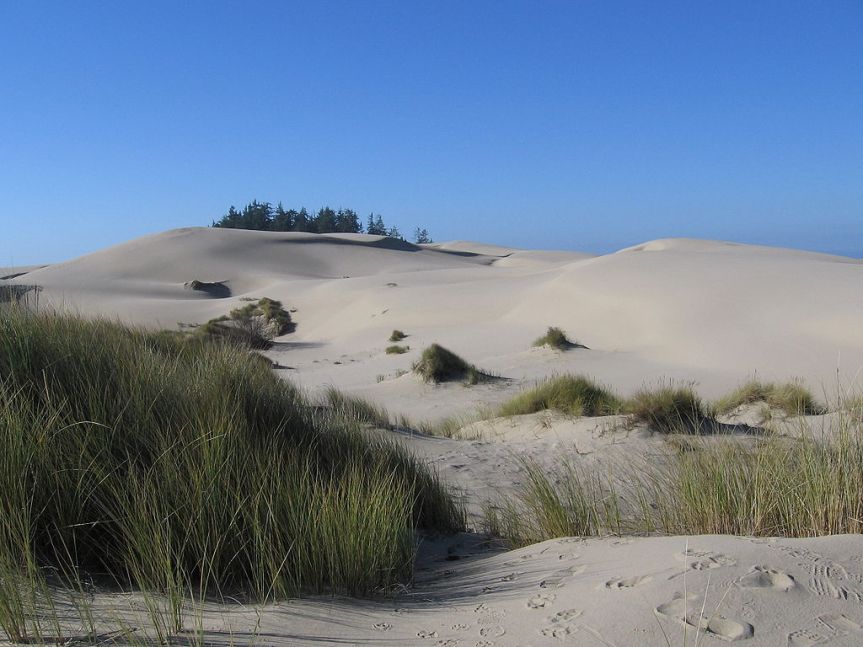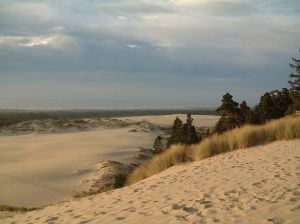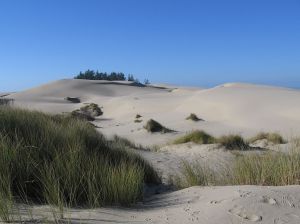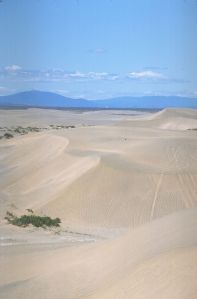I am strapped into a double shoulder-harness tightened down until my torso doesn’t budge. I tug on the helmet chin-straps and adjust the seal of my protective goggles. I peer over at Larry. I feel a demented grin spreading across my face.
“Ready?”
He nods briefly, tugging on his straps and belts and buckles, cautiously eyeing the roll-bar stretched over our heads. We are seated in a sand-rail, ready to explore the Oregon Dunes, the largest expanse of coastal sand dunes in North America, with over 40 miles designated as a National Recreational Park.
Our driver is an energetic man named Jack. After double-checking that all our limbs are safely ensconced inside the vehicle, verifying we understand the safety rules and unconditionally accept all possible risk of bodily harm, injury or death, he leaps behind the wheel and roars the engine to life. We trundle down a forested trail on enormous tires displacing the sand with paddle-shaped forms. As the transitional forest fades away, we stop at the edge of a giant dune falling away at an oblique angle. I peer over the sandy ridge and gasp at the sheer drop. Spread out before us, transverse mounds of sand undulate to the horizon like waves on the ocean.
“Do you want to go out there?” Jack asks, his voice trilling in anticipation.
“Yes!” I clap excitedly, looking around for a trail leading down to the dunes. Instead, Jack points the nose of the sand-rail directly over the edge of the cliff and guns the engine. I squeal as we plummet straight down the sandy precipice. It feels like falling.
The astonishing physical phenomenon of the Oregon Dunes is continually being shaped by the powerful forces of wind and water colliding against a unique geological landscape. Sedimentary rock, eroded from the Coast Mountain Range, is pulverized into sand by gushing rivers tumbling towards the sea. Strong ocean currents trap the sediment against the shoreline, and powerful winter waves dredge the sand onto the beaches. The constant coastal winds sculpt the dunes along a sloping sandstone marine terrace. With no natural barrier, like the steep headlands found elsewhere along the Oregon Coast, the wind can push the sand for miles inland.
Jack is a speed demon. He roars up sand dunes 300 feet high, the sand-rail hovering momentarily as it crests the peak, before rocketing down in a flourish of rakish angles and breathtaking velocity. The sky and sand and ocean tumble together in an improbable kaleidoscope. I gasp and scream and laugh as I’m jostled in my seat. Flying sand stings my cheeks, lodges in my hair, and sticks to my teeth.
Having temporarily satisfied his need for speed, Jack slows down enough to point out some of the diverse ecosystems formed by encroaching dunes. He drives around an island of trees floating in the sand like an oasis in the desert. Isolated remnants of coastal forest are being buried alive by constantly shifting sands. He points out wet, marshy areas between the dunes where rising water tables from winter rains saturate the sand to form pockets of quicksand. As we make our way back, we drive alongside the vegetation-covered deflation plains separating the inland dunes from the beach. Closer to the ocean, we can see the knobby hummock mounds encircling sparse low-lying vegetation, giving way to beach grasses swaying in the wind along the foredune running parallel to the water’s edge.
As I clamber out of the sand-rail, shaking sand from my clothes, I marvel at the majestic intricacies of nature’s playground. For the remainder of the day, I buzz and bounce, grinning maniacally. Who knew geology could be such a rush!




